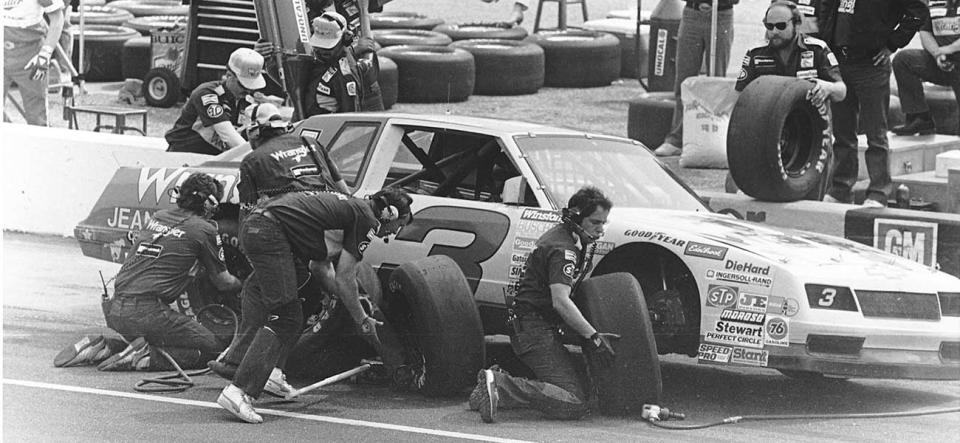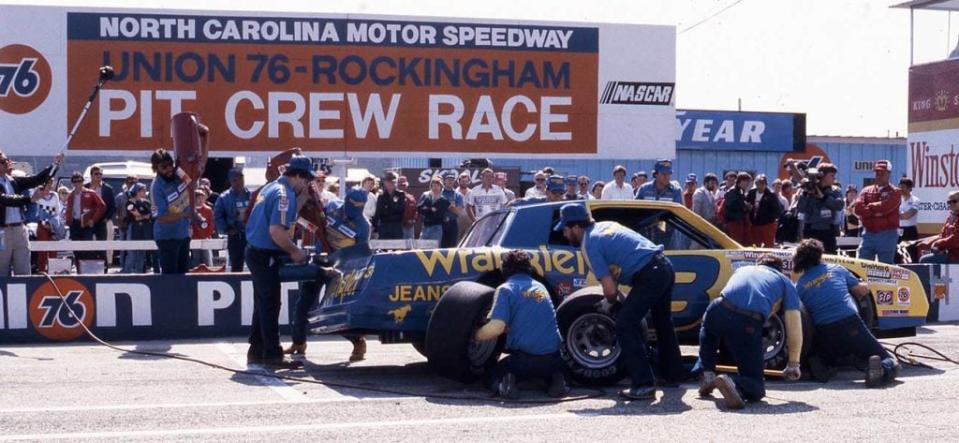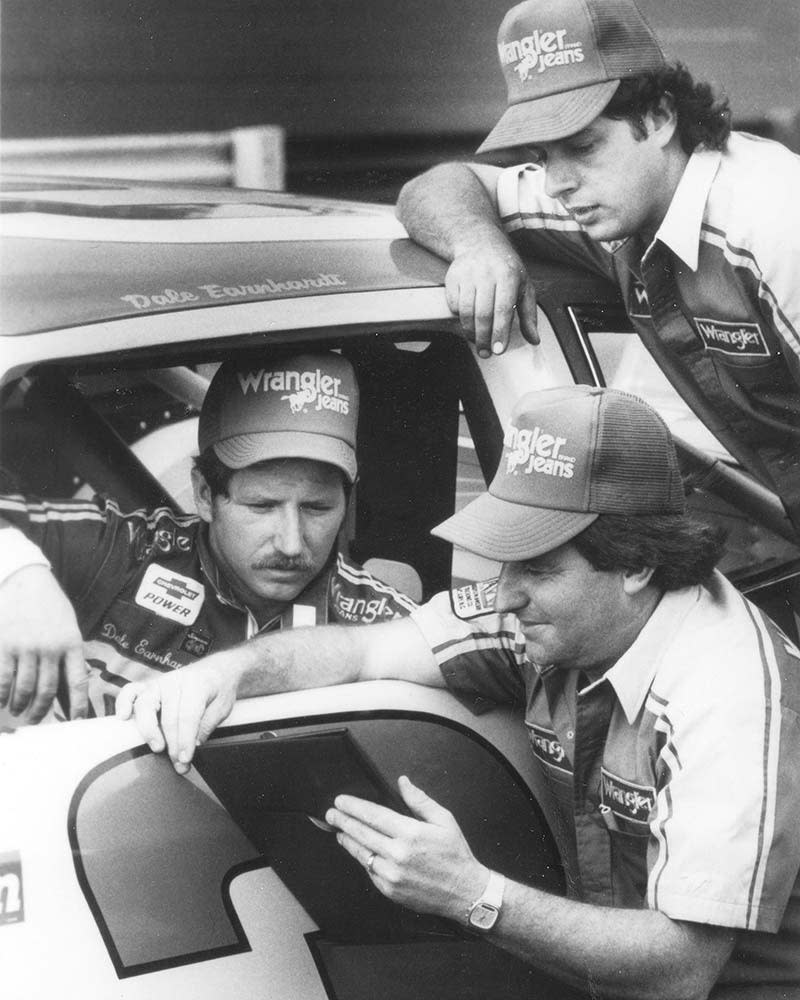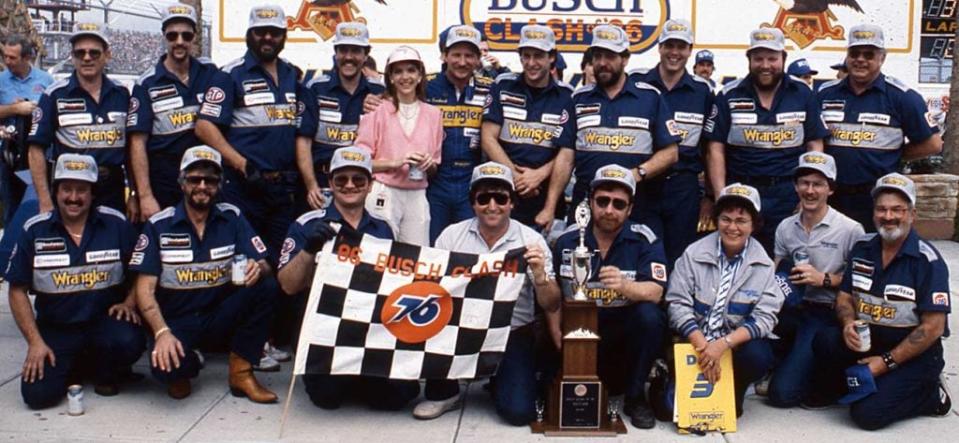From 'Junk Yard Dog' pit-crew roots, Kirk Shelmerdine carves distinctive path to Hall of Fame
When Bill Brodrick, a longtime public relations rep for Union Oil, wanted to further promote the company’s sponsorship of NASCAR’s annual pit-crew competition, he had an idea.
Brodrick was already a larger-than-life figure as Victory Lane’s ringmaster, orchestrating the weekly “hat dance” of sponsor photos after each race win. His omnipresence and distinctive reddish mane made him stand out as “The Hat Man,” a term he later trademarked. But Brodrick also wanted extra oomph behind Unocal’s pit-stop contest, and as the sport began another stage of growth in the mid-1980s, he sought to amplify the competition’s stars of the hour.
Broderick’s idea materialized in the form of a photo shoot with veteran Dozier Mobley behind the lens, a theme-heavy campaign that emphasized the Richard Childress Racing No. 3 team’s rough edges, and a tagline that ended up sticking.
“Brodrick has this scheme in his head, how he wanted it to look and everything. We took several photos, and only one ended up being the final one,” says Kirk Shelmerdine, then the crew chief for the No. 3 Chevrolet and its driver, Dale Earnhardt. “But there’s some scrapyard there near the airbase at Dover, and he had a little smoke machine and everything else to do it.
“He wanted to get a little momentum going on that facet of the team. It was cool because we were already on the map, but it kind of made it more public.”
Rising from the artificial smoke at that Delaware scrap heap in their Wrangler gear was the newly christened “Junk Yard Dogs” — from left, fueler and enforcer Danny “Chocolate” Myers with a massive chain draped on his shoulders; Shelmerdine, who doubled as the front-tire changer; Will Lind, the rear-tire changer and tire specialist; David Smith, the team’s top lieutenant on chassis and engine detail, leaning on the jack he wielded in his over-the-wall duties; and Cecil Gordon, the longtime independent driver who became RCR’s shop foreman, his arm resting on the trusty No. 3 pit sign.
The Junkyard Dogs pic.twitter.com/oT03aS1STw
— Wrangler3Goodwrench (@wrangler3chevy) June 16, 2017
The ragtag setting and the crew’s tough-guy expressions said, “don’t mess with us.” But the theme also underscored the blue-collar work ethic and the edge that made the RCR crew the champions of the pit-stop competition for an unprecedented four consecutive years.
“The reason it was like that, the Junk Yard Dogs, we were pretty scrappy back in the day,” Myers says now. “We kind of did our own deal, right? We weren’t very polished. We had a good time at the race track, and we had a good time when we were away from the race track, right? I guess the only set of rules that we had was when that garage area opens, no matter what you did the night before, when they open that gate to that garage area, you better be the first ones through that gate. And that is a true fact.”
Shelmerdine, the driven leader of that No. 3 crew, will follow the path of Earnhardt and Childress into the NASCAR Hall of Fame during Friday night’s induction ceremony (8 p.m. ET, Peacock, MRN), where he’ll join Matt Kenseth and Hershel McGriff as the Class of 2023’s honorees. His four Cup Series championships top the list of his Hall credentials, but Shelmerdine will also be celebrated as the architect of a workhorse crew that bridged the time between the Wood Brothers’ early pit-stop choreography in the 1960s to the revolutionary teamwork of the No. 24 Rainbow Warriors group in the ’90s.
RELATED: Class of 2023 induction info | Complete list of Hall of Famers
Their success also spanned two different eras of nicknames. The “Junk Yard Dogs” theme overlapped with Wrangler’s “One Tough Customer” branding that synced so well with Earnhardt’s persona. When GM Goodwrench entered as the No. 3 team’s primary sponsor with a sinister black paint scheme for 1988, Earnhardt grew into his “Intimidator” image, and the advertising redubbed the pit crew as the “Flying Aces” as part of their new look.
“If you’re going to get a nickname,” says Lind, “I guess that wasn’t a bad one.”
Forming a bond
Before the Junk Yard Dogs crew found a home with Richard Childress, the core of the group first met in pairs. Myers was a south-sider in Winston-Salem, North Carolina, and Smith grew up in the community of Rural Hall just north of town. The two were regular companions at the weekly races at Bowman Gray Stadium and formed a natural bond with Childress, who set up shop just south of the Twin Cities in Welcome.

Shelmerdine and Lind were the outsiders, geography-wise. Shelmerdine was a Pennsylvania transplant who opted against enrollment at Penn State at the 11th hour to head south and stake out a career in racing at just 18. Lind moved northbound from his native Lakeland, Florida, looking for the same opportunity. They met each other in the middle, at the race shop of veteran driver James Hylton.
“When I first started there with Hylton, I pretty much didn’t know anything about race cars,” Shelmerdine said. “I couldn’t believe they were letting me touch it. It was a pretty steep curve from there on.”
Says Lind: “You’re very limited on what you could do, but that is how everybody had to learn back then. You basically were a go-fer to start with until you proved that you could actually touch the car.”
When Childress put the pairs together, the personalities made for an intriguing blend — both in their at-track roles and their choice of extracurriculars when on the road. Lind and Myers made sure nightlife was a part of their travel, but Smith was a by-the-book teetotaler.
“Chocolate and I were unfortunately more alike,” Lind says. “We were like a match and gas, and so we ran hard, and Richard did, too. Kirk would kind of hang out, but he was like a one-beer guy and didn’t stay up late. And David was very religious. David had seen hard times and cleaned his life up. It’s very, very true, man. I’ve told this so many times over the years. Kirk was from Pennsylvania, David was from Rural Hall, Chocolate was from Winston, but I was from Florida, and we kind of just had very, very different personalities that got along.
“I’m a firm believer that chemistry can’t be created. I don’t think it’s driven by the coach I think it’s more about the people. For some reason, that chemistry just happens, and so we were actually pretty good for whatever reason there was.”
Smith died in 2016 after battling cancer, but his legacy of innovation endures. Shelmerdine says Smith was instrumental in developing the hydraulics of the lighter-weight aluminum jack, fine-tuning the tool to lift the car in just one pump. “David was probably the best jackman ever,” Shelmerdine says. “It’s kind of like the center on the basketball team, you know. The whole pit stop pivots around when the car gets up and down.”
April 7, 1991- David Smith, Kirk Shelmerdine, Dale Earnhardt, and Will Lind prior to the TranSouth 500 at Darlington. The Goodwrench Chevrolet would finish 32nd after an engine failure. Earnhardt completed 332 laps. #NASCAR pic.twitter.com/jZx5GVcWbX
— Jay Coker (@jcoker1) April 7, 2022
Gordon’s inclusion in the Junk Yard photo came by happenstance, Myers says. The former journeyman racer was more of a race-shop presence, but also managed the handful of “weekend warrior” auxiliary crew members that were part of the team’s at-track personnel rotation. Gordon died in 2012.
“He probably taught me as much about the sport as anybody I’ve worked with,” Lind said. “You’re around him every day and he was quick to guide you away from heading down the wrong road, and he was just a just a good teacher and a good man. Hell of a good friend.”
At the helm was Shelmerdine, who helped all those personalities mesh and who led by quiet, purposeful example. His role as crew chief was one of oversight, but his hands-on nature came out in his versatility. Shelmerdine’s skill as a chassis specialist helped provide Earnhardt with race-winning setups, but the willingness to do multiple jobs to make the team click was a shared attribute among the group.
“Nobody expected us to do the things that we did, so everybody kind of pulled together,” Myers says. “And Kirk was the leader, he made the decisions, but I think it was respect for everybody is the reason that, man, it was successful. I never thought about it that way until just now, but you know, we went to work, carved out a plan, and nobody ever questioned that we did what we needed to do. …
“What made everything work was nobody wanted to let anybody else down. No matter what you needed to do, nobody ever said ‘that’s not my job.’ Nobody ever said, ‘I don’t get paid for this.’ We all did anything and everything. We had specific jobs that we did, right, but we all looked after each other. We all worked for the common cause.”
Says Shelmerdine: “We had just kind of been through it all together. … It really was a good match. Just everybody got along. Of course, everybody loved Dale and Richard and it was bigger than all of us. A kind of a snowball had gotten rolling there, and we were all sort of dedicated to doing what we had to do to keep it rolling.”

Over the wall in competition
The Unocal 76 World Pit Crew Competition was an annual exhibition at Rockingham Speedway that began in 1967. Not surprisingly, the Wood Brothers were among the event’s earliest champions, but when the competition format switched from two-tire stops to changing all four in 1985, RCR’s No. 3 crew began its four-year run.
That stretch came just before Ray Evernham and his Rainbow Warriors made the evolutionary approach of molding pit crews into professional sports teams. When the Childress crew began to dominate, pit-stop drills back at the shop weren’t a regular part of the preparations.
“Our practice was every weekend at the race track, and we were pretty daggone successful with that,” Myers says. “I think it was all desire and dedication, determination. One of the things that I’ll say on the radio a lot is, it didn’t really matter when it didn’t really matter. We had so many things back then that, it was just different. If we didn’t practice, it didn’t really hurt us because nobody else practiced either.”
Says Shelmerdine: “We just had it down really good. We were that fast, and a lot of it sometimes, you slow down to go faster. A lot of it is just not taking unnecessary steps.”
MORE: Kirk Shelmerdine Hall of Fame profile
Of course, back then a crew chief wouldn’t be swinging around the nose of the car, air hose in hand, to change tires. Shelmerdine made that process a part of his regular routine for years, all in the last era of when cars navigated pit road without a speed-limit rule.

“For a crew chief to be watching the race, calling the race, and then call a pit stop and get down off the box and go perform the pit stop?” Myers says with a sustained laugh. “That would be unheard of (today).”
The competition itself measured the elapsed time for the car tripping a timing light on its way to the pit stall, then the time for teams to change all four tires and add gas. That total included time penalties for loose lug nuts, errant tires and leftover fuel.
Shelmerdine recalls the No. 3 team lowering its record-setting time in each of its four consecutive victories. In 1987, when another crew introduced a new technique, the rest of the teams picked up on it; RCR’s group adapted quickest to the switch — without the benefit of practicing it beforehand.
Earnhardt — who won his third Cup Series title that season — joined in pushing the car to Victory Lane. “It was kind of funny because he got as big a kick out of us winning as we did,” Lind says.
A sign touting the pit-crew championship has sat alongside the Junk Yard Dogs photo at RCR for years, illustrating how those showcase wins were a point of pride for both driver and crew. Lind has won several championship rings during his time in the sport, but said he counts his pit-crew title ring among his most cherished.
The team’s success under that spotlight translated to a swagger, something that Earnhardt always seemed to have in stock.
“You’d walk through that garage area knowing that you were the pit-crew champions, you’d have your chest poked out a little bit,” Myers said. “To win that thing was really big.”

From the Junk Yard to the Hall
Kirk Shelmerdine admits that he lost track of the timing of Hall of Fame Voting Day last year. Day-to-day domestic tasks were on his list, and the gravity of the moment didn’t kick in until later.
“I was doing stuff around the house and then the phone started blowing up,” Shelmerdine recalled. “Holy smokes, here we go.”
Months after the news of his teammate’s enshrinement broke, Will Lind started making notes, mainly to document the team’s accomplishments. Since retiring from RCR in 2017, Lind’s slower-paced days now are kept occupied with leisurely car restoration and watching his grandchildren’s rec-sports games. His notes are an effort to preserve the firsthand memories from the crew’s busier times on the NASCAR circuit.
“I think the fact that even while we were doing it, I don’t think we realized that we were pretty good at it, you know what I mean?” Lind says. “Again, it sounds vain, but at the time, we were one of the few teams to win it back to back. I felt like I was almost in a coma while I was racing, because so many things went past in my life that I don’t even hardly remember. And we were all the same way; it wasn’t just me. I mean, we were all so focused on that deal.”
MORE: Shelmerdine, Kenseth, McGriff elected to NHOF
Those stories and remembrances from that era should be some of the highlights of induction night, when many of the RCR team are expected to gather and catch up with their former crew chief. Myers, whose gift of gab has a regular audience these days on SiriusXM NASCAR Radio, has those stories in spades.
“We were winning races, we were winning championships, and when you went somewhere, people knew who you were and you wanted to kind of represent yourself and the company and the sponsor,” Myers says. “We were sponsored by Wrangler, so having a new pair of blue jeans, that wasn’t anything special. We were expected to do that and to really do well for the sponsor. But Shelmerdine, I don’t know if he ever wore new blue jeans. We would go somewhere and he would have the worst pair of blue jeans with holes in them sometimes. He was not the flamboyant guy. He was not the ‘look at me’ guy. He was not the guy that was polished when it came to the TV cameras. He was just Kirk. He said what he was thinking, he was not politically correct and it did not bother him to go out to eat with executives, when they were all suit and tie and he was blue jeans and a flannel shirt. That did not bother him at all. He was not self-conscious about it. I think the best way to say about Kirk, he was comfortable in his own skin.”
Comfortable, his former teammates recall, but also a reluctant star on one of the era’s top teams. “Misunderstood” was how Danny Lawrence, longtime engine builder and current RCR managing director of team alliances and Xfinity operations, described Shelmerdine, noting how his low-profile excellence was almost underestimated at the time.
“Kirk never went after that,” Lind says. “He never did interviews. Another thing that was probably as opposite about him and today’s crew chief is he was not all about being on TV and promoting himself, and he wasn’t even much about jumping up and down and hooting and hollering when we won the race. He was just a very low-key emotion kind of guy.
“So to see him in Hall of Fame, that makes you start looking at it. I knew I was lucky to be a part of something like that, after the fact. But to see that it’s finally getting rewarded and just to have been a small part of it is pretty satisfying.”
The spotlight he never really sought out will firmly be on Shelmerdine and his fellow inductees in Charlotte’s Crown Ballroom on Friday evening. Those suits and ties that he mingled with so effortlessly in the Wrangler days will be there, but expect a bit of Junk Yard Dog chic amid the more formal niceties.
“I think it’s a big deal, and I think it may be a bigger deal when it happens,” Myers says. “Whether it’s just him being nonchalant, not uptight or not worrying about it … it wouldn’t surprise me if he had on blue jeans or a flannel shirt, to be honest with you.”

 Yahoo Sports
Yahoo Sports 
